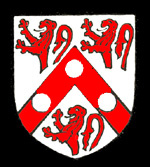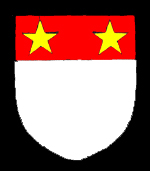Southill Manor

The arms of Warden Abbey
Volume III of The Victoria County History for Bedfordshire, published in 1912, gives a details of the manors in the parish of Southill. Southill Manor itself originated in two hides, one virgate, held by Hugh de Beauchamp, later Baron of Bedford as recorded in Domesday Book of 1086. The book records seven holdings in total in what is now the parish of Southill.
It seems likely that a member of the de Beauchamp family alienated the manor to Warden Abbey because a charter of 1198 includes mention of land in Southill. Certainly, the abbot claimed the manor in 1330. Warden Abbey was dissolved by King Henry VIII (1509-1547) in 1537 when Southill Manor was appraised at £32/18/10 per annum.

The Fisher family coat of arms
In 1506 Sir John and Agnes Fisher had granted a property known as Fisher's Grange to the abbey. In 1543 this property was acquired by Sir Michael Fisher.

The Saint John family coat of arms
The property passed to the Saint John family of Bletsoe by the marriage of Sir Michael's granddaughter Agnes to Oliver, Lord Saint John, who died in 1582. Oliver Saint John, 1st Earl Bolingbroke inherited Fisher's Grange but before 1641 had also acquired the Manor of Southill, probably by purchase from the Crown. He was killed fighting for Parliament at the Battle of Edgehill, the first major battle of the First Civil war, in 1642.
At some point the manor passed from the Saint John family to the Ongley family of Old Warden because in 1792 Robert, 2nd Baron Onlgey held it. the greater part of the Ongley family lands in Southill were exchanged with the Whitbread family for lands in Old Warden in the early 19th century. However, the Ongleys retained Southill Manor and Robert, 3rd Baron Ongley sold it to Joseph Shuttleworth of Old Warden between 1869 and 1873. The Shuttleworth family held the manor into the 20th century until a succession of Law of Property Acts in the 1920s abolished manorial fines and incidents as well as copyhold land tenure, thus abolishing manors in practically all but name.